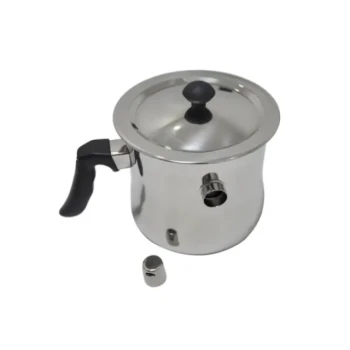To separate honey from wax, you will use a two-stage process based on their different densities. First, allow the bulk of the honey to drain away from the wax cappings or crushed comb using gravity. Then, use heat and water to melt and "render" the remaining wax, which will float to the top, separating it cleanly from any residual honey and impurities.
The entire separation process hinges on a simple principle: honey is the densest, wax is the least dense, and water sits in the middle. By using gravity and heat, you can effectively stratify these materials to harvest both pure honey and clean beeswax.
The Two-Stage Separation Process
For the most effective results, beekeepers use a combination of a "cold" gravity-based method followed by a "hot" rendering method. This maximizes the yield and purity of both products.
Stage 1: Gravity Separation (The Cold Drain)
This initial step is designed to get the vast majority of the liquid honey out of the comb with minimal effort.
You simply place your wax cappings or crushed honeycomb into a container with a filter or sieve at the bottom, like a bucket with a honey gate or a large strainer placed over a clean bucket.
Over a period of 12-24 hours, gravity will do the work. The heavy, viscous honey will slowly drip down and collect in the bottom container, leaving behind a semi-dry mass of wax.
Stage 2: Rendering with Heat & Water (The Hot Wash)
This second stage is for purifying the wax that was left behind after the gravity drain. This wax still contains trapped honey, pollen, and other hive debris.
The process involves melting the wax in water. As the wax melts, the less-dense, oil-based wax will float on top of the water.
Heavier impurities and water-soluble honey will sink to the bottom or dissolve into the water itself. Once the mixture cools, the purified wax will solidify into a clean disc on the surface, which can be easily lifted off.
Understanding the Trade-offs and Best Practices
Achieving a clean separation requires attention to detail. Avoiding common mistakes is crucial for maintaining the quality of both your honey and your wax.
Avoid Overheating the Wax
Beeswax has a relatively low melting point (around 144-147°F or 62-64°C). Never boil the wax or heat it directly in a pot without water.
Overheating can darken the wax, destroy its pleasant aroma, and degrade its quality. A gentle double boiler or a dedicated wax melter is the ideal tool.
Mind Your Materials
Use stainless steel or food-grade enamel pots for melting wax. Other metals, like iron or brass, can react with the wax and cause discoloration.
The water used for rendering will absorb the remaining honey. Do not discard it. This sweet "honey water" can be used to feed bees or as a base for making mead.
Making the Right Choice for Your Goal
Your approach depends on whether your priority is harvesting the honey or purifying the wax.
- If your primary focus is harvesting liquid honey: The gravity separation stage is the most important step. Let the honey drain thoroughly before you even consider processing the wax.
- If your primary focus is creating clean beeswax for candles or crafts: The heat and water rendering stage is essential. You may even need to repeat this washing and melting process two or three times to achieve a perfectly pure block of wax.
Ultimately, mastering this two-stage process allows you to respectfully use everything the bees provide, ensuring nothing goes to waste.
Summary Table:
| Step | Method | Purpose | Key Consideration |
|---|---|---|---|
| Stage 1 | Gravity Drain (Cold) | Separate bulk honey from wax | Use a sieve or honey gate; takes 12-24 hours |
| Stage 2 | Heat & Water Rendering (Hot) | Purify remaining wax from honey/debris | Avoid overheating (max 147°F / 64°C) |
Ready to scale your honey and wax harvesting? As a leading wholesale supplier to commercial apiaries and distributors, HONESTBEE provides the durable, high-volume equipment you need—from honey gates and strainers to commercial wax melters. Let our expertise help you maximize your yield and efficiency. Contact our team today to discuss your operation's needs.
Related Products
- HONESTBEE 3-Frame Manual Acrylic Honey Extractor
- HONESTBEE 6 Frame Three Use Electric Honey Extractor for Beekeeping
- 8-Frame Electric Self-Reversing Honey Extractor Spinner for Commercial Honey Extraction Equipment
- 6 Frame Manual Stainless Steel Honey Extractor Beekeeping Equipment
- Commercial Electric 12 Frame Honey Extractor Spinner Motorized Honey Extractor
People Also Ask
- What should be done with wet frames after honey extraction? A Guide to Efficient Apiary Management
- What factors should be considered when choosing a honey extractor machine? Maximize Your Harvest Efficiency
- Why is cleaning a honey extractor important in beekeeping? Protect Your Honey Quality & Equipment
- What are the essential tools and tips for a successful honey harvest in beekeeping? Maximize Your Yield with the Right Equipment
- How do you extract honey step by step? A Complete Guide to Harvesting Pure Honey



















